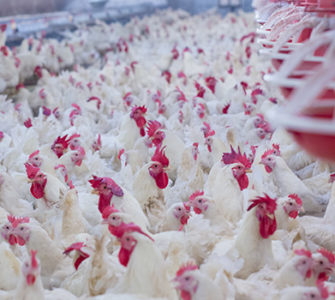Sanderson vet: Keeping up with variant reovirus strains remains challenging
Poor uniformity, lameness and reduced water consumption are tip-offs that broilers may be infected with variant reovirus, Erin Riley, DVM, staff veterinarian at Sanderson Farms, told Poultry Health Today.
The epidemiology for variant reovirus isn’t clear, Riley said, but it spread across the southern US very rapidly through transport of live poultry and hatching eggs.
When the latest epidemic first emerged in 2012, it was a sizeable problem because hen flocks were naïve. Once vaccination with a killed autogenous product was initiated in pullets, variant reovirus became less of a problem, but it still occurs, he said.
Multiple hen flocks affected
![]() At Sanderson Farms, signs of variant reovirus start between 28 and 35 days of age in broilers grown to 50 or 60 days of age. When the virus first strikes, multiple hen flocks tend to be affected, and wherever their broilers are placed, there are typically two or three houses per farm affected. In his experience, broilers mostly become infected due to vertical transmission, although horizontal transmission can occur.
At Sanderson Farms, signs of variant reovirus start between 28 and 35 days of age in broilers grown to 50 or 60 days of age. When the virus first strikes, multiple hen flocks tend to be affected, and wherever their broilers are placed, there are typically two or three houses per farm affected. In his experience, broilers mostly become infected due to vertical transmission, although horizontal transmission can occur.
When viral arthritis is suspected, blood is sent for ELISA at least 2 weeks after the onset of clinical signs, and the results from that assay are typically clear. The titers will be very high if there’s a significant reovirus causing viral arthritis, Riley continued.
Next there’s a historical search to figure out if the virus that’s causing the current problem is the same that caused a problem before or if a new variant has emerged. Whole legs are collected and sent to a number of different labs for virus isolation and characterization, he said.
Behind the eight-ball
“We tend now to blame the problem on poor vaccine administration or immunosuppressive disease, but there’s always the possibility of another variant,” Riley said, and therein lies the challenge. “You’re always behind the eight-ball because by the time you find a problematic virus, you then have to isolate it, see if it is a good vaccine candidate, make a vaccine, and by that time, you’re months behind.”
Although Sanderson Farms has done well controlling variant reovirus with autogenous vaccines, there’s always the question of efficacy because autogenous vaccines aren’t subject to the stringent requirements required of conventional, licensed commercial vaccines. “You always question if you have the right bug,” he said.
Nevertheless, when confronted with variant reovirus, “I would say that autogenous vaccine development should be obviously a big focus, and spending the time and effort and money to choose the right viruses is critical,” Riley said.
Posted on March 6, 2020

















